What is prostatitis? We will analyze the causes, diagnosis and treatment methods in the article of a doctor, urologist with 28 years of experience.
Definition of the disease. Causes of the disease
ProstatitisPain in the lower back, perineum or pelvic region is also an inflammatory process of prostate tissue, accompanied by disturbances in the functioning of the lower urinary tract.
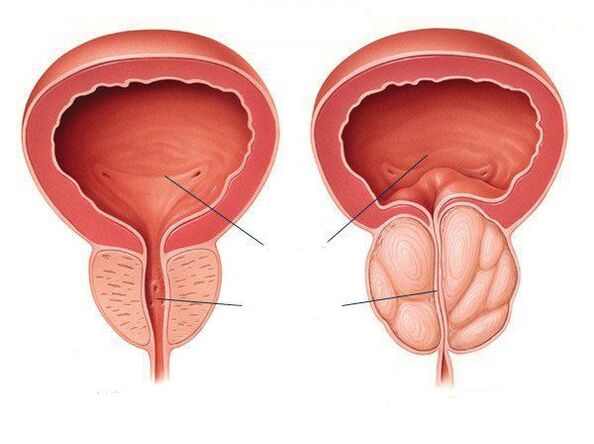
The prostate gland (prostate) belongs to the male reproductive system. It sits in front of the rectum, under the bladder, and covers the urethra (urethra). For this reason, when the prostate gland becomes inflamed, it compresses the urethra, which causes various problems with urination. The main function of the prostate is to produce a secretion (fluid) that is part of the sperm and liquefies it to ensure normal sperm motility.
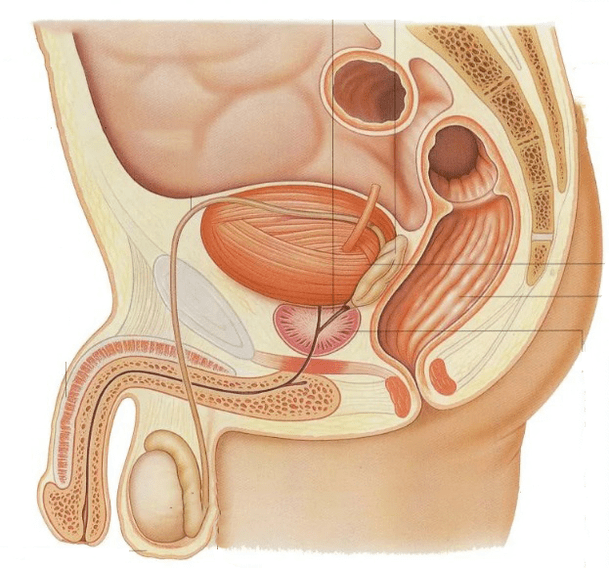
Pathological conditions of the prostate gland, such as cancer or benign hyperplasia, are more common in older patients. Prostatitis affects men of all ages, but most often the disease occurs in men of reproductive age (between 8-35% of cases).
Prostatitis most commonly occurs in urologist practice. It can occur suddenly (acutely) or gradually, and its manifestations are persistent and long-term (chronic). The chronic form is more common than the acute form. Chronic prostatitis ranks fifth among the twenty major urological diagnoses.
Prostatitis can be either an independent disease or combined with benign prostatic hyperplasia and prostate cancer. In recent years, there has been a decline in prostatitis in the male population: if in 2012 there were 275 cases per 100, 000 population, in 2017 there were 203 primary diseases per 100, 000 population.
Causes of prostatitisbacterial (infectious) and non-bacterial (non-infectious).Infectious prostatitismost common in men under 35 years of age. This form of the disease is often caused by gram-negative microorganisms, especially enterobacteria, E. coli, serration, pseudomonas and proteus, as well as gonococci, chlamydia and others. As caused by sexually transmitted infections. In very rare cases, prostatitis can occur. mycobacterial tuberculosis. In chronic bacterial prostatitis, the spectrum of pathogens is wider and may include atypical pathogens. It should be remembered that chronic bacterial prostatitis is a polyetiological disease, which can have several causes.
Factors contributing to the development of inflammationprostate gland:
- sexually transmitted infections;
- immune deficiency conditions;
- prostate biopsy;
- invasive manipulation and operations;
- Life style;
- diarrhea, constipation;
- homosexual intercourse;
- frequent change of sexual partners;
- sedentary lifestyle, etc.
Chronic non-bacterial prostatitisIt is diagnosed in patients with chronic pain in the prostate area, in which no infectious (bacterial) causative agent of the disease is found. Despite numerous studies, the cause of this type of chronic prostatitis is not clear, but there are some factors that can lead to its development:
- increased prostate pressure;
- muscle pain in the pelvic region;
- emotional disorders;
- Autoimmune diseases (antibodies that need to fight infection, sometimes for some reason attack the cells of the prostate gland);
- physical activity;
- irregular sex life;
- lift weights and so on.
In some cases, it can occur after transurethral procedures such as prostatitis, urethral catheterization, or cystoscopy, and after a transrectal biopsy of the prostate.
Although the incidence of different types of prostatitis has not been definitively determined, the following information is provided:
- acute bacterial prostatitis accounts for approximately 5-10% of all prostatitis cases;
- chronic bacterial prostatitis - 6-10%;
- chronic non-bacterial prostatitis - 80-90%;
- Prostatitis, including prostatodinia (neurovegetative disorders of the prostate gland) - 20-30%.
If you find similar symptoms, consult your doctor. Do not self-medicate - it is dangerous for your health!
Symptoms of prostatitis
All forms of inflammationThe prostate gland, in addition to asymptomatic, is associated with the presence of the following symptoms:
- pain in the lower back;
- feeling of discomfort with intestinal peristalsis;
- pain in the perineum or pelvic region;
- Disorders of the lower urinary tract.
The main symptoms of the lower urinary tract in the presence of prostatitis:
- desire to urinate often;
- difficulty urinating, i. e. a weak flow and the need for "straining";
- burning pain or intensification when urinating.
In diagnosed menacute bacterial prostatitisPelvic pain and urinary tract symptoms such as increased urination and urinary retention occur. This can lead to the development of systemic manifestations such as fever, chills, nausea, vomiting and weakness. Acute bacterial prostatitis is characterized by an acute onset of the disease with a vivid clinical picture. This is a serious disease.
Diagnosed menchronic bacterial prostatitisnote the symptoms of an increasing and decreasing periodic nature. Pain and discomfort with an exacerbation are noted. Pain is more localized at the base of the penis, around the anus or above. In addition, the pain can spread to the upper part of the groin or back, penis and testicles. Defecation is also painful. Sometimes symptoms of infection of the lower parts of the urinary system develop: burning pain and frequent urination, frequent urination. These symptoms can be confused with the manifestations of acute bacterial prostatitis, but usually begin suddenly, with chills, fever, weakness, frequent and painful urination, pain in the genitals, as well as in the lumbar region, with ejaculation. If you find such symptoms, you should see a doctor immediately.
If the standard modern examination does not determine that the chronic pain is caused by a pathological process in the prostate gland, we also deal with chronic non-bacterial prostatitis, which is calledchronic pelvic pain syndrome(the term has been used since 2003). When there is a chronic pelvic pain syndrome, a man's quality of life is significantly reduced, because this syndrome sometimes leads to various psychological and sexual disorders:
- increased fatigue;
- to feel helpless;
- erectile dysfunction;
- painful ejaculation;
- pain after sexual intercourse, etc.
In chronic non-bacterial prostatitis / chronic pelvic pain syndrome, persistent discomfort or pain is felt at the base of the penis and around the anus for at least 3 months. Pain is localized in one "target organ" or several pelvic organs. Often, the pain in the form of prostatitis is localized in the prostate gland (46%).
Sexual disorders in chronic prostatitis have a number of features. First, all components of a man's copulatory (sexual) function are disturbed to varying degrees: libido, erection, ejaculation. Second, sexual dysfunction occurs mainly in individuals with a long (more than 5 years) history of the disease. Third, sexual dysfunction is often the main reason for seeking medical attention.
Erectile dysfunction is noted in 30% of patients suffering from chronic prostatitis, mainly due to the psychogenic factor - the catastrophic perception of the disease.
Symptoms of prostatitis occur at least once in a lifetime in 50% of men.
Pathogenesis of prostatitis
The mechanism of development of prostatitis is multifaceted and very complex. Many factors are involved in its development. Acute bacterial prostatitis is most often caused by a rising urethral infection or a cascade process caused by intraprostatic reflux (urine backflow).
Penetration of microorganisms into the prostate gland is possible by increased route (through the urethra) or transrectally through the lymph. Diarrhea and constipation associated with rectal barrier dysfunction are considered a trigger in chronic prostatitis. However, the mechanism by which microorganisms penetrate the prostate is still unclear.
Urinary incontinence with prostatitis can be caused by:
- increase the tone of the smooth muscles of the prostate urethra by increasing the activity of adrenergic receptors;
- enlargement or narrowing of the urethra, turbulent urination, bladder outflow obstruction, and intraprostatic reflux.
In the future, there is a violation of the drainage of the prostate ducts, stagnation of prostate secretions, edema, activation of the arachidonic acid cascade, inflammation and ischemia. A closed circle of pathological changes occurs.
Classification and developmental stages of prostatitis
There are 4 main categories (types) of prostatitis.
- Acute bacterial prostatitis(category I).
- Chronic bacterial prostatitis(category II).
- Chronic non-bacterial prostatitis / syndromechronic pelvic pain (category III). It can be inflammatory (category III A) or non-inflammatory (category III B).
- Asymptomatic inflammatory prostatitis.Histological prostatitis determined by prostate biopsy (category IV).
Chronic bacterial prostatitisNot differentspicymanifests itself as a recurrent flare-up episode with or without complete remission. Symptoms are generally less severe than acute prostatitis.
Classification of National American Institutes of Health. . .
- I type(acute bacterial prostatitis) - an acute infection of the prostate gland: the symptoms of the disease appear suddenly. Cold, fever, body aches, weakness, pain in the lower back and genitals, frequent, painful urination, pain during ejaculation. Potential symptoms of acute bacterial prostatitis include blood and / or semen in the urine. It is rare. It is effectively treated with antibiotics.
- Type II(chronic bacterial prostatitis) - a chronic or recurrent infection of the prostate gland: symptoms are similar to those of acute prostatitis, but appear gradually and are less pronounced. Several courses of antibiotic therapy may be required.
- Type III(chronic non-bacterial prostatitis and chronic pelvic pain syndrome): no evidence of infection.
- Type III A: presence of leukocytes in the third part of the urine taken after ejaculation / prostate secretion / prostate massage.
- Type III B: Absence of leukocytes in the third part of the urine taken during ejaculation / prostate secretion / prostate massage. Pain in the lower back and genitals, frequent urination, difficulty urinating (often at night), burning or painful urination and discharge. It accounts for about 90% of all prostatitis cases. There are no known causes or clinically proven treatments.
- Type IV(asymptomatic inflammatory prostatitis): Sometimes an increase in the number of white blood cells. No treatment is required. Detected by prostate biopsy.
The boundaries between the different forms of prostatitis are broken.
Complications of prostatitis
With inflammatory lesions of the prostate gland, nearby organs are involved in the pathological process: seminal tubercle, Cooper's glands, seminal vesicles and posterior urethra. The infection can simultaneously penetrate the prostate gland and surrounding organs.
Vesiculitis- Inflammation of the seminal vesicles. The pain deepens in the groin and pelvis and spreads to the sacrum. The pain is usually unilateral because both seed vesicles are affected to varying degrees. Vesiculitis may be asymptomatic. The only complaint of patients may be the presence of blood in the semen. Periodic pyuria (pus in the urine) and pyospermia (pus in the discharge) are also noted.
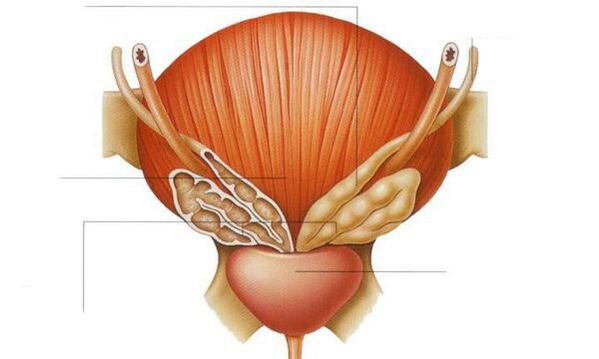
Posterior urethritis, colliculitis (inflammation of the seminal tubercle). . . Infection with prostatitis penetrates the seminal tubercle, which is due to the proximity of the prostate gland to the secretory ducts.
Prostate abscess.Pathogens that cause prostatitis can also cause prostate abscess. It is a severe septic (bacterial) disease accompanied by weakness, fever, sweating chills. In some cases, poor consciousness and delirium are observed. The patient needs to be hospitalized.
Prostate sclerosis (fibrosis).It is a late complication based on the replacement of prostate tissue with scars (connective tissue degeneration, ie sclerosis), which leads to shrinkage of the gland, reduction in size and complete loss of function. As a rule, sclerotic symptoms develop long after the onset of the inflammatory process in the prostate gland.
Prostate cysts.These formations can contribute to the formation of stones in the prostate gland. The presence of an infection in the cyst can cause a prostate abscess. Prostate cysts are not difficult to diagnose using ultrasound. These can also be detected by digital rectal examination.
Prostate stones.They are quite common. The causes of the disease are not clear, but most experts believe that they are the result of a long-term inflammatory process in the prostate gland. The stones are single and numerous, with a diameter of 1 to 4 mm. Large stones are rare. The stones block the gland, so there is stagnation in the gland, the gland stretches too much, and individual cysts are formed, including the infection. Patients with prostate stones should experience persistent dull pain in the perineum. Painful sensations spread to the glans penis and often urge to urinate, which is difficult and painful.
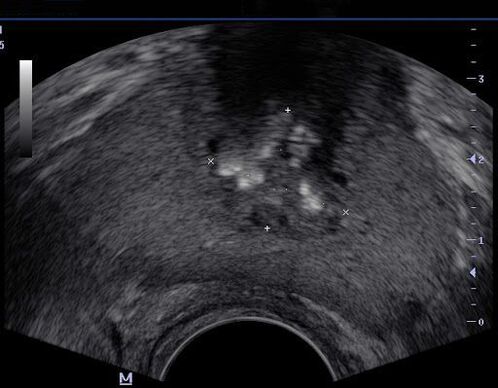
Infertility.Chronic long-term prostatitis primarily reduces the motor function of sperm and makes them completely immobile. One of the consequences is the disruption of their production, the formation of immature sperm with an unusually altered shape (and fewer than before).
Discharge disorder.In any form, prostatitis causes sexual dysfunction. At first, patients experience premature ejaculation, have a normal erection, then weaken and the rate of orgasm decreases. Prolonged chronic prostatitis contributes to a decrease in the production of male sex hormones and a decrease in libido.
Erectile dysfunction.The link between chronic prostatitis / chronic pelvic pain syndrome and erectile dysfunction has been explained. This disorder is especially painful for men.
Diagnosed with prostatitis
The appearance of the first signs of inflammation of the prostate gland requires urgent medical attention. The urologist will rule out many diseases with similar manifestations and determine the category (type) of the disease. Before choosing a treatment, a specialist will conduct the necessary examinations and offer to pass an evaluation test.
What questions can the doctor ask?
At the appointment, the doctor will definitely specify: the duration of clinical manifestations of the disease, the location and nature of the pain, for example, the perineum, scrotum, penis and inner thigh; changes in the nature of sperm (pus and blood).
At the reception, the urologist will offer to fill out special questionnaires, one of which is the index of symptoms of chronic prostatitis.
The patient should ask the doctor questionswhat tests and tests need to be done, how to prepare for them, what treatment I plan to prescribe, and where I can get more information about the disease.
Chronic bacterial prostatitis is diagnosed when symptoms persist for at least three months.
The survey includes:
- Digital rectal examination of the gland to determine the degree and consistency of prostate growth.
- Prostate, urine and / or ejaculatory secretion tests.
- Diagnosis of urogenital infection.
- Ultrasound examination of the urinary system (kidneys, prostate, bladder with residual urine).
- Urodynamic research.
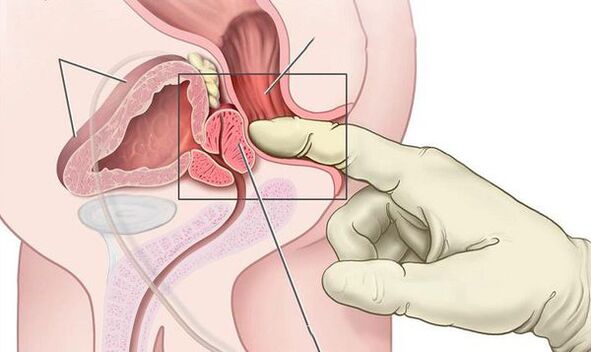
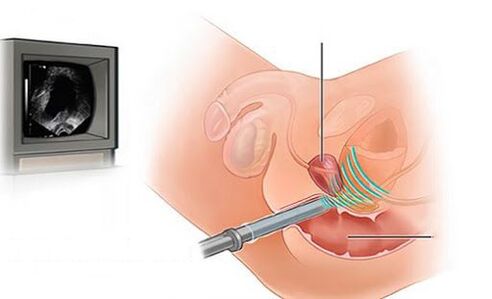
In the case of acute bacterial prostatitis, a swollen and painful prostate gland can be detected by digital rectal examination. Prostate massage is contraindicated because it can cause bacteremia and sepsis.
The most important work in the examination of patients with acute bacterial prostatitis is the cultivation of prostate secretions. Quantitative culture and microscopy of urine samples and prostate secretions obtained after prostate massage are still important methods for categorizing chronic prostatitis.
Androflor - a comprehensive study of the microbiocenosis of the urogenital tract in men with PCR. Allows to determine the qualitative and quantitative composition of the microflora. It is used to monitor the diagnosis and treatment of inflammatory diseases of the genitourinary system.
After determining the cause of the disease, the doctor will recommend a course of treatment. We must not forget that only 5-10% of standard methods can detect an infection that causes prostatitis.
What is the link between prostatitis, prostate specific antigen (PSA) and prostate cancer?
Measurement of total PSA and free PSA levels in prostatitis does not provide additional diagnostic information. Prostate-specific antigen (PSA) levels are known to increase in 60 and 20 percent of patients with acute and chronic bacterial prostatitis, respectively. PSA levels decrease in 40% of patients after treatment. PSA is not considered a specific indicator for prostate cancer because PSA levels can rise in benign prostatic hyperplasia and prostatitis.
Treatment of prostatitis
Drug treatment plays a leading role in the treatment of pathology.
Treatment with alpha1-blockers
Alpha1-blockers are prescribed for patients who have difficulty urinating. These drugs help to facilitate urination and relax the muscles of the prostate gland and bladder. Some patients are given medications to lower their hormone levels, which can help narrow the pancreas and reduce anxiety. Muscle relaxants can help relieve pain caused by the swollen prostate putting pressure on nearby muscles. Non-steroidal anti-inflammatory drugs (NSAIDs) can help with pain.
In most cases, standard antibiotic therapy does not reduce the number of relapses of the disease, and therefore an integrated approach is often used and prescribed.auxiliary drugs: biostimulants, extracts of various plants and insects and their biological componentsrectal suppository. . . Despite the large arsenal of drugs, the effectiveness of their use remains insufficient.
Physiotherapy in the treatment of prostatitis
Physiotherapeutic methods for chronic prostatitis of II, III A and III B categories can be used in addition:
- prostate massage (prostate);
- laser therapy;
- microwave hyperthermia and thermotherapy;
- electrical stimulation of the skin or rectal electrodes with modulated currents;
- acupuncture (acupuncture).
The effectiveness and safety of these treatments are still being studied. It is also used to treat prostatitisfolk methodsfor examplehirudotherapy.The effectiveness and safety of this method for the treatment of prostatitis has not been proven.
Stem cell injection
Cell therapy (stem cell injections) in the treatment of prostatitis is currently a promising method in the early stages of development. At present, in connection with the injection of stem cells into the prostate, we can only make assumptions about its mechanisms and empirical data obtained by individual research groups.
Surgical treatment of prostatitis
Surgical methods are used only to treat complications of prostatitis - abscesses and removal of seminal vesicles.
Treatment of chronic pelvic pain syndrome requires separate consideration. Asymptomatic inflammatory prostatitis (category IV) should not be treated unless the patient plans to have prostate surgery. In this case, the patient is given a course of prophylactic antibiotic therapy.
Diet and lifestyle for prostatitis
No special diet is required for prostatitis, but many vegetables, lean meats and dairy products will improve bowel function. It is important to consume enough fiber, foods rich in vitamin E (wheat germ, corn oil, etc. ), sugar should be replaced with natural honey. Proper nutrition for prostatitis improves bowel function and can reduce the likelihood of relapse or speed recovery. It is recommended to lead a healthy lifestyle, drink more fluids and limit caffeine and alcohol.
Forecast. Prophylaxis
Acute prostatitis often becomes chronic with timely and adequate treatment.
Complete recovery is not always possible, but anxiety and pain can be relieved by proper consistent therapy and following the doctor's recommendations. Independenttreatment of prostatitis at homecan be dangerous and can lead to complications.
Not all cases of prostatitis can be identified as a cause, but there are several steps you can take to prevent prostatitis from occurring. The same steps can help manage existing symptoms:
- Drink plenty of fluids. Drinking too much fluid often leads to urination, which makes it easier for the prostate to flush infectious substances out of the urethra.
- Empty the bladder regularly.
- Avoid urinary tract irritation. Limit caffeine, spicy foods and alcohol.
- Reduces pressure on the prostateMen who ride bicycles often need to use a split seat to reduce prostate pressure.
- Be sexually active.



























